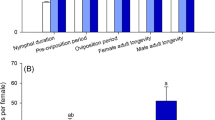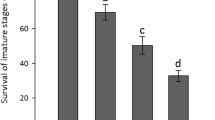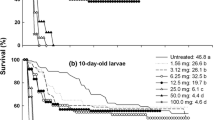Abstract
Recently, Apolygus lucorum (Hemiptera: Miridae) has become an important insect pest of Bt cotton and fruit trees in China. At present, the application of chemical insecticides is the main control option for this pest. We investigated the lethal effect of seven neonicotinoid insecticides on A. lucorum adults, including six commercialized neonicotinoids and a novel one, cycloxaprid, which is developed in China. In addition, we assessed the sublethal physiological (longevity, fecundity) and behavioral (pre-oviposition and oviposition periods) effects of LD10 (low lethal dose) and LD40 (moderate lethal dose) of cycloxaprid on the mirid bug. Lethal effect of the insecticides was determined using a topical exposure method; contact toxicity against the adults was ranked as follows: cycloxaprid, nitenpyram > clothianidin > acetamiprid, imidacloprid > thiamethoxam > dinotefuran. Among these insecticides, the toxicity of cycloxaprid against the adults was the highest; its LD50 value was 2.54 ng a.i. (active ingredient)/adult. Both LD10 (0.74 ng a.i./adult) and LD40 (1.98 ng a.i./adult) of cycloxaprid induced sublethal effects in the adults; we observed a reduced longevity in males and the LD40 also shortened the longevity of females. In addition, the LD40 prolonged the pre-oviposition period and shortened the oviposition period of females, and it decreased their fecundity. The hatching rate of eggs laid by the females exposed to LD10 and LD40 greatly decreased (two-fold lower when exposed to LD40). Our results demonstrate that cycloxaprid is among the best candidate insecticides for controlling A. lucorum, and it showed significant lethal and sublethal effects on this mirid bug.




Similar content being viewed by others
References
Ahmad M, Ossiewatsch HR, Basedow T (2003) Effects of neem-treated aphids as food/hosts on their predators and parasitoids. J Appl Entomol 127:458–464
Alyokhin A, Dively G, Patterson M, Castaldo C, Rogers D, Mahoney M, Wollam J (2007) Resistance and cross-resistance to imidacloprid and thiamethoxam in the Colorado potato beetle Leptinotarsa decemlineata. Pest Manag Sci 63:32–41
Biondi A, Desneux N, Siscaro G, Zappalà L (2012) Using organic-certified rather than synthetic pesticides may not be safer for biological control agents: selectivity and side effects of 14 pesticides on the predator Orius laevigatus. Chemosphere 87:803–812
Christopher Cutler G, Ramanaidu K, Astatkie T, Isman MB (2009) Green peach aphid, Myzus persicae (Hemiptera: Aphididae), reproduction during exposure to sublethal concentrations of imidacloprid and azadirachtin. Pest Manag Sci 65:205–209
Croft BA (1990) Arthropod Biological Control Agents and Pesticides. Wiley, Hoboken
Cui L, Sun LN, Yang DB, Yan XJ, Yuan HZ (2012) Effects of cycloxaprid, a novel cis-nitromethylene neonicotinoid insecticide, on the feeding behaviour of Sitobion avenae. Pest Manag Sci 68:1484–1491
Desneux N, Wajnberg E, Fauvergue X, Privet S, Kaiser L (2004a) Oviposition behaviour and patch-time allocation in two aphid parasitoids exposed to deltamethrin residues. Entomol Exp Appl 112:227–235
Desneux N, Pham-Delègue MH, Kaiser L (2004b) Effects of sublethal and lethal doses of lambda-cyhalothrin on oviposition experience and host searching behaviour of a parasitic wasp, Aphidius ervi. Pest Manag Sci 60:381–389
Desneux N, Fauvergue X, Dechaume-Moncharmont FX, Kerhoas L, Ballanger Y, Kaiser L (2005) Diaeretiella rapae limits Myzus persicae populations following applications of deltamethrin in oilseed rape. J Econ Entomol 98:9–17
Desneux N, Denoyelle R, Kaiser L (2006) A multi-step bioassay to assess the effect of the deltamethrin on the parasitic wasp Aphidius ervi. Chemosphere 65:1697–1706
Desneux N, Decourtye A, Delpuech JM (2007) The sublethal effects of pesticides on beneficial arthropods. Ann Rev Entomol 52:81–106
Elbert A, Haas M, Springer B, Thielert W, Nauen R (2008) Applied aspects of neonicotinoid uses in crop protection. Pest Manag Sci 64:1099–1105
Fogel MN, Schneider MI, Desneux N, González B, Ronco AE (2013) Impact of the neonicotinoid acetamiprid on immature stages of the predator Eriopis connexa (Coleoptera: Coccinellidae). Ecotoxicology 22:1063–1071
Guo TE, Zhang ZQ, Zhou C, Liu F, Mu W (2010) Susceptibilities of Lygus lucorum Meyer-Dür (Hemiptera: Miridae) from five cotton-growing regions in Shandong, China to selected insecticides. Acta Entomol Sin 53:993–1000
Han P, Niu CY, Lei CL, Cui JJ, Desneux N (2010a) Quantification of toxins in a Cry1Ac? CpTI cotton cultivar and its potential effects on the honey bee Apis mellifera L. Ecotoxicology 19:1452–1459
Han P, Niu CY, Lei CL, Cui JJ, Desneux N (2010b) Use of an innovative T-tube maze assay and the Proboscis Extension Response assay to assess sublethal effects of GM products and pesticides on learning capacity of the honey bee Apis mellifera L. Ecotoxicology 19:1612–1619
He YX, Zhao JW, Zheng Y, Desneux N, Wu KM (2012) Lethal effect of imidacloprid on the coccinellid predator Serangium japonicum and sublethal effects on predator voracity and on functional response to the whitefly Bemisia tabaci. Ecotoxicology 21:1291–1300
Hua RM, Cao HQ, Xu GW, Tang F, Li XD (2004) The integrative toxicity effects of beta-cypermethrin on Propylea japonica larvae and Aphis gossiypii adults. Acta Phytophyl Sin 31:96–100
Jeschke P, Nauen R (2008) Neonicotinoids—from zero to hero in insecticide chemistry. Pest Manag Sci 64:1084–1098
LeOra (1987) POLO-PC a User’s Guide to Probitor Logit Analysis. LeOra, Berkeley, CA
Li YF, Gao ZL, Dang ZH, Wang JQ, Yang JK, Pan WL (2008) Evaluation on the toxicity and control effect of different kinds insecticides to Lygocoris lucorum M. J Hebei Agri Sci 12(49–50):57
Liang P, Tian YA, Biondi A, Desneux N, Gao XW (2012) Short-term and transgenerational effects of the neonicotinoid nitenpyram on susceptibility to insecticides in two whitefly species. Ecotoxicology 21:1889–1898
Liu ZW, Williamson MS, Lansdell SJ, Denholm I, Han ZJ, Millar NS (2005) A nicotinic acetylcholine receptor mutation conferring target-site resistance to imidacloprid in Nilaparvata lugens (brown planthopper). Proc Natl Acad Sci USA 102:8420–8425
Liu BS, Zhang ZC, Xie L, Zhang GF, Wang LH (2013) Comparison of biological activity and field efficiency of cycloxaprid and other new neonicotinoid insecticides to rice planthoppers. Southwest China J Agri Sci 26:155–158
Lu YH, Wu KM (2008) Biology and Control of Cotton Mirids. Golden Shield Press, China
Lu YH, Wu KM (2011) Mirid bugs in China: pest status and management strategies. Outlooks Pest Manag 22:248–252
Lu YH, Qiu F, Feng HQ, Li HB, Yang ZC, Wyckhuys KAG, Wu KM (2008a) Species composition and seasonal abundance of pestiferous plant bugs (Hemiptera: Miridae) on Bt cotton in China. Crop Prot 27:465–472
Lu YH, Wu KM, Cai XM, Liu YQ (2008b) A rearing method for mirids using the green bean, Phaseolus vulgaris in the laboratory. Acta Phytophyl Sin 35:251–269
Lu YH, Wu KM, Jiang YY, Xia B, Li P, Feng HQ, Wyckhuys KAG, Guo YY (2010a) Mirid bug outbreaks in multiple crops correlated with wide-scale adoption of Bt cotton in China. Science 328:1151–1154
Lu YH, Wu KM, Wyckhuys KAG, Guo YY (2010b) Temperature-dependent life history of the green plant bug, Apolygus lucorum (Meyer-Dür)(Hemiptera: Miridae). Appl Entomol Zool 45:387–393
Lu YH, Wu KM, Jiang YY, Guo YY, Desneux N (2012) Widespread adoption of Bt cotton and insecticide decrease promotes biocontrol services. Nature 487:362–365
Men XY, Yu Y, Zhang AS, Li LL, Zhang SC, Liu TJ (2011) Toxicity of 10 insecticides to the nymphs of Apolygus lucorum, assayed by residual films. Plant Prot 37:154–157
Miao J, Du ZB, Wu YQ, Gong ZJ, Jiang YL, Duan Y, Li T, Lei CL (2014) Sub-lethal effects of four neonicotinoid seed treatments on the demography and feeding behaviour of the wheat aphid Sitobion avenae. Pest Manag Sci 70:55–59
Mota-Sanchez D, Hollingworth RM, Grafius EJ, Moyer DD (2006) Resistance and cross-resistance to neonicotinoid insecticides and spinosad in the Colorado potato beetle, Leptinotarsa decemlineata (Say)(Coleoptera: Chrysomelidae). Pest Manag Sci 62:30–37
Nauen R, Denholm I (2005) Resistance of insect pests to neonicotinoid insecticides: current status and future prospects. Arch Insect Biochem Physiol 58:200–215
Nauen R, Koob B, Elbert A (1998) Antifeedant effects of sublethal dosages of imidacloprid on Bemisia tabaci. Entomol Exp Appl 88:287–293
Ramirez-Romero R, Desneux N, Decourtye A, Chaffiol A, Pham-Delègue MH (2008) Does Cry1Ab protein affect learning performance of the honey bee Apis mellifera L. (Hymenoptera: Apidae)? Ecotox Environ Safe 70:327–333
SAS Institute (2005) SAS/STAT User’s Guide, version 9.13: Cary, NC, USA
Shao XS, Fu H, Xu XY, Xu XL, Liu ZW, Li Z, Qian XH (2009) Divalent and oxabridged neonicotinoids constructed by dialdehydes and nitromethylene analogues of imidacloprid: design, synthesis, crystal structure, and insecticidal activities. J Agric Food Chem 58:2696–2702
Shao XS, Ye ZJ, Bao HB, Liu ZW, Xu XY, Li Z, Qian XH (2011) Advanced research on cis-neonicotinoids. Int J Chem 65:957–960
Shao XS, Liu ZW, Xu XY, Li Z, Qian XH (2013a) Overall status of neonicotinoid insecticides in China: production, application and innovation. J Pestic Sci 38:1–9
Shao XS, Swenson TL, Casida JE (2013b) Cycloxaprid insecticide: nicotinic acetylcholine receptor binding site and metabolism. J Agric Food Chem 61:7883–7888
Shi XB, Jiang LL, Wang HY, Qiao K, Wang D, Wang KY (2011) Toxicities and sublethal effects of seven neonicotinoid insecticides on survival, growth and reproduction of imidacloprid-resistant cotton aphid, Aphis gossypii. Pest Manag Sci 67:1528–1533
Szendrei Z, Grafius E, Byrne A, Ziegler A (2012) Resistance to neonicotinoid insecticides in field populations of the Colorado potato beetle (Coleoptera: Chrysomelidae). Pest Manag Sci 68:941–946
Tan Y, Biondi A, Desneux N, Gao XW (2012) Assessment of physiological sublethal effects of imidacloprid on the mirid bug Apolygus lucorum (Meyer-Dür). Ecotoxicology 21:1989–1997
Tomizawa M, Casida JE (2003) Selective toxicity of neonicotinoids attributable to specificity of insect and mammalian nicotinic receptors. Ann Rev Entomol 48:339–364
Tomizawa M, Zhang N, Durkin KA, Olmstead MM, Casida JE (2003) The neonicotinoid electronegative pharmacophore plays the crucial role in the high affinity and selectivity for the Drosophila nicotinic receptor: an anomaly for the nicotinoid cation-π interaction model. Biochemistry 42:7819–7827
Torres JB, Ruberson JR (2004) Toxicity of thiamethoxam and imidacloprid to Podisus nigrispinus (Dallas)(Heteroptera: Pentatomidae) nymphs associated to aphid and whitefly control in cotton. Neo Entomol 33:99–106
Way M (1954) The effect of body weight on the resistance to insecticides of the last-instar larva of Diataraxia oleracea L., the tomato moth. Ann Appl Bio 41:77–87
Wu KM, Li W, Feng HQ, Guo YY (2002) Seasonal abundance of the mirids, Lygus lucorum and Adelphocoris spp. (Hemiptera: Miridae) on Bt cotton in northern China. Crop Prot 21:997–1002
Zhang ZQ, Guo TE, Wang W, Liu F, Mu W (2009) Assessment of relative toxicity of insecticides to the green plant bug, Lygus lucorum Meyer-Dur (Hemiptera: Miridae), by two different bioassay methods. Acta Entomol Sin 52:967–973
Zhang LL, Lu YH, Liang GM (2013) A method for field assessment of plant injury elicited by the salivary proteins of Apolygus lucorum. Entomol Exp Appl 149:292–297
Acknowledgments
The authors thank Dr. Fengshou Dong (Institute of Plant Protection, Chinese Academy of Agricultural Sciences) for his assistance in collecting the six commercial insecticides. This research was supported by the Special Fund for Agro-scientific Research in the Public Interest (201103012) and the National Natural Science Funds (No. 31321004).
Author information
Authors and Affiliations
Corresponding author
Additional information
Communicated by M. Traugott.
Electronic supplementary material
Below is the link to the electronic supplementary material.
Rights and permissions
About this article
Cite this article
Pan, H., Liu, Y., Liu, B. et al. Lethal and sublethal effects of cycloxaprid, a novel cis-nitromethylene neonicotinoid insecticide, on the mirid bug Apolygus lucorum . J Pest Sci 87, 731–738 (2014). https://doi.org/10.1007/s10340-014-0610-6
Received:
Revised:
Accepted:
Published:
Issue Date:
DOI: https://doi.org/10.1007/s10340-014-0610-6




